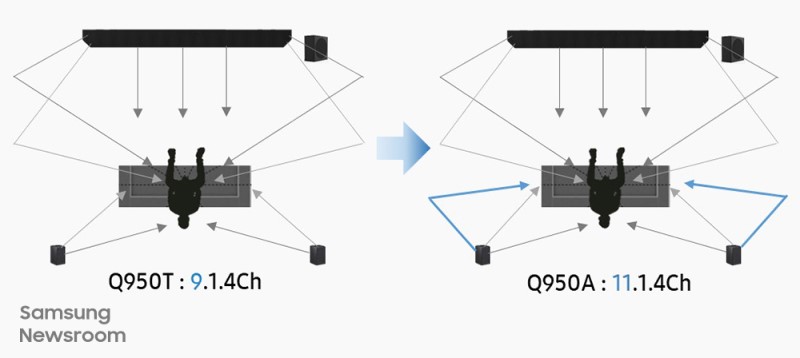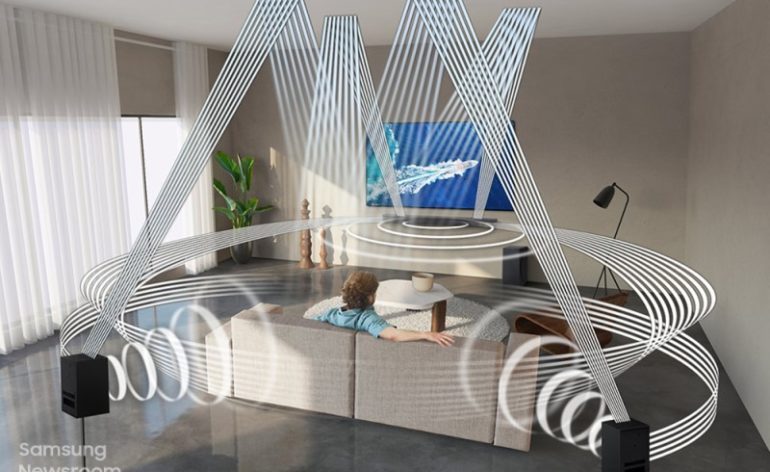Just STOP With the Atmos Soundbars!
Recently, Samsung announced the first 11.1.4 soundbar (link). That’s right, they are trying to convince you that a soundbar solution can recreate the experience of a full 11.1.4 Atmos speaker system. We’ve seen the technology, and we have some concerns. Let’s start with a statement: Stop. Just stop with the Atmos soundbars. They aren’t Atmos, they don’t work the way you say they do, and they aren’t any better than other soundbars. So stop.
Author’s Note: We are picking Samsung in this article because of their recent announcement. But this applies to all manufacturers of “Atmos” soundbars.
These “Atmos” Soundbars aren’t Atmos
We’ve described how to properly set up an Atmos speaker system. It consists of some floor-level speakers paired with some speakers mounted or installed into the ceiling. While there are up-firing Atmos speakers that are designed to “bounce” the sound off the ceiling (that’s a completely different article), those are always considered inferior to physical speakers. So, these Atmos soundbars are always starting off at a disadvantage. But it gets worse.
In order to properly bounce the sound around the room, you must know the shape of the room, right? Either that or you have to make assumptions about the shape of the room. Most “Atmos” soundbars just have a couple of speakers on the bar that fire upwards and leave it at that. If you think they are actually bouncing anything off the ceiling, I’ve got a bridge to sell you. Samsung is a little different. Let’s take a look.
Samsung’s “Solution” to Your Room
The proper way to calibrate a speaker system is to play test tones through the speakers, measure with a microphone at your couch, and set the volume levels and distances. That’s not what Samsung does. Instead, they have a “SpaceFit Sound” feature. This is actually a system that they built into some of their flat panel displays. They included a microphone in their displays which measures (in some way) the room and adjusts the tone of the sound to compensate. They have a video on it which makes it clear this is nothing more than tone controls. That’s not a bad thing, it should help if you are using the TV speakers. If you have a QLED from Samsung with the included microphone and SpaceFit Sound feature, you can use this with your new Samsung soundbar. Again, just tone control. Not actual calibration.
But don’t worry, Samsung has an “Auto EQ” function. Surely, this will properly set up the speakers for your room! Well, no, it won’t. They included a microphone in the system. But a quick glance at the manual let us know it is only to calibrate the bass. That microphone? Installed in the subwoofer. The soundbar and surrounds won’t even play during the EQ. Applying some EQ to your bass is definitely something you want, but it doesn’t solve the problem of the system not knowing your room. I mean, look at these diagrams! Just look at them!

How can the sound possibly be bouncing around your room so accurately if your walls aren’t perfectly spaced apart? How can it bounce the sound off your ceiling if it doesn’t know the height of your room or where you are sitting? Can any of this stuff work the way they are claiming it does?
That’s Not How Any of this Works
They aren’t bouncing sound off of crap. That’s right, I said it. There isn’t any bouncing going on. They tell you that there is because they want people to expect it to work. And bouncing sound around a room makes sense when you don’t think about it too much. But that’s not what is happening. What is happening is that they are varying the phase of the speakers to trick your ear into thinking the sound is coming from other directions. This is common. It’s how you hear the singer’s voice coming out of the space between your two stereo speakers. It’s how the sound can go from one side of the room to the other with only stereo speakers. This is old technology. Heck, I heard a soundbar over a dozen years ago that could do it very well with only a handful of drivers in it.
But then why do the Atmos soundbars have speakers facing in different directions? Psychology. If they didn’t have speakers facing different directions, people would never believe that the sound could come from anywhere else but from the soundbar. By adding the different-facing speakers, you begin to believe. Between that and the adjustments in the phase, you identify the sound as coming from different directions. No, they don’t need all these different drivers facing in different directions, but people do. People need to see them so that they’ll believe that it will work.
Atmos Soundbars are about the Money
So, if the Atmos part of the Atmos soundbar doesn’t need all those drivers to create the effect, why include them? Couldn’t they just eliminate some of the drivers, reduce their costs, and make more money? They could if the Atmos soundbar and the regular soundbar had the same MSRP. But they don’t. The Atmos soundbar costs a premium. A regular soundbar might cost a couple hundred dollars. An Atmos soundbar? Easily over a thousand. And those extra drivers? Probably a quarter a piece. Atmos soundbars are nothing but profit. So, stop with the Atmos soundbars already.
Conclusion
If you are shopping for a soundbar, there are things you want. Atmos shouldn’t be one of them. It’s a buzzword that convinces people they are getting more than they actually are. If you have to buy a soundbar, get one with a real subwoofer output so you can add an actual subwoofer (not the bass modules included with most soundbars). Get one that has wireless surround speakers. Heck, get one that says “simulated surround” if you want. Just don’t pay a premium for Atmos.



Wow, incredibly mis-informed and lacking any evidence whatsoever. Got any proof that ALL Atmos sound bars use phase differences exclusively? It reads like the author watched a YouTube video on psychoacoustics and wrote an article based on that. So you’re saying sound doesn’t reflect? Oh, I guess reverb doesn’t exist then. Why do studios and home cinema enthusiasts put sound dampening foam around areas of the room? So you don’t hurt yourself when walking into the walls?
I have personally used ‘inferior’ Atmos up firing speakers and can attest that they do indeed work as advertised. Sound does travel through the air and reflect / bounce off a surface giving the illusion that the sound is coming from the reflection point. The sound is more diffuse, yes, but that can be more desirable in certain situations.
Don’t even get me started on the section regarding a singers voice coming from the centre of a stereo setup. That’s phase too is it? Ever heard of panning? Play the same sound from both speakers and it comes from the centre. Pan it left or right and it comes from the left or right and gives the impression of a sound moving from one side to the other. Nothing to do with phase. Phase can be used as a trick to widen a sound stage beyond the physical placement of the speakers, but to say you don’t get any ‘bounce’ at all is incredibly ignorant of the physics of sound. Do some research before posting nonsense.